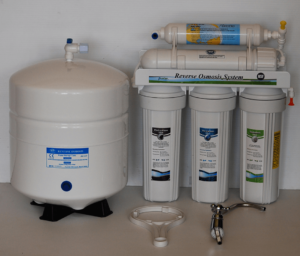Table of Contents

In this blog, we will discuss everything related to reverse osmosis and determine whether this process of removing minerals from water is a myth or fact.
By the end of this blog, you’ll understand reverse osmosis and how it affects the quality of your water.
Does Reverse Osmosis Remove Minerals? – All You Need To Know
There are several different ways to remove minerals and other contaminants from water, but one of the most effective is known as reverse osmosis.
This process works by forcing water molecules through a fine filter that only allows the water to pass and traps the minerals and other contaminants.
While this process is very effective, it can also be very expensive, which is why it is typically only used in cases where it is necessary.
For example, reverse osmosis is often used to purify water used in scientific laboratories or provide drinking water for people living in areas where the water is unsafe to drink.
What is not removed by reverse osmosis?
Yes, Reverse Osmosis Removes Minerals
Reverse osmosis (RO) is a method of purifying water.
It uses pressure and a membrane to remove all minerals from your water, including calcium, magnesium, and potassium.
RO removes these minerals because they are not soluble in the type of water produced by RO machines, and it is a physical, not a chemical process.
The water enters through the membrane and passes through its pores before leaving the system as pure drinking water.
It means that RO tends to remove large particles more efficiently than small ones.
In addition to removing mineral content from your water, RO also removes some organic compounds, such as bacteria and viruses, which are harmful when ingested through tap water or soft drinks.
Removing All Kinds Of Impurities
RO can filter out various contaminants, including lead, arsenic, and fluoride.
It also removes chlorine and other chemicals, such as ammonia and chloramines.
Organic chemicals are removed by the pore size of the RO membranes.
The larger the pores are, the more organic matter will filter out.
How Does Reverse Osmosis Work?
The reverse osmosis process involves applying pressure to force water through a membrane that blocks the larger particles and lets the water pass through.
The membrane is made of a polymer material with an ion exchange resin thin film.
The result is that RO can remove up to 95% of dissolved salts from your drinking water while leaving behind any other additives like fluoride or chlorine.
RO works by having two semipermeable membranes.
The inside membrane is called the ultrafiltration filter, and the outside is called reverse osmosis.
The inside filter uses high pressure to push out large molecules like salt.
Still, it allows smaller molecules, such as oxygen, back into your drinking water, thus removing them from your tap water altogether.
What If You Need Minerals In Your Water?
What if you want minerals back in your water after they are removed by reverse osmosis?
Well, that is simple enough.
To reclaim your minerals, you can do a few things.
- Use a carbon filter that will allow the minerals to flow through the filter and back into your water supply.
If you have an issue with scale build-up on your pipes or faucet, this might be worth looking into.
- Add baking soda (sodium bicarbonate) to your RO system as a coagulant that will help remove any residue left over after the minerals have been removed during filtration.
It can help with taste and scale build-up problems on pipes and faucets.
It also helps to add trace minerals such as calcium and magnesium, which you remove during RO processing.
- Use alkaline water filters that allow alkaline ions and small amounts of sodium chloride to pass through their pores.
Is Reverse Osmosis Water Worth The Cost?
Reverse osmosis water is often seen as a good water choice because it is said to be healthy for you.
However, many believe reverse osmosis water is not as good as other types of water.
There are many reasons why people believe this, but the most popular one is that it is often too expensive.
Another reason is that some people believe that the process of reverse osmosis removes healthy minerals from the water.
While the process of reverse osmosis is often expensive, the end product is said to be much healthier for you.
This water goes through a process of filtration to remove impurities and contaminants.
The result is much purer water than you would find in your regular tap.
Because of this, many people believe that the benefits of drinking reverse osmosis water are worth the cost.
Wrapping It Up
In conclusion, the reverse osmosis filtration process does remove minerals from water.
It can have positive and negative effects depending on the situation.
For example, some people might want to add minerals back into their water after filtration for health reasons, while others might want to avoid any minerals in their drinking water.
Ultimately, it is up to the individual to decide what is best for them.



